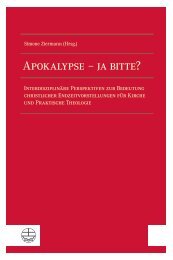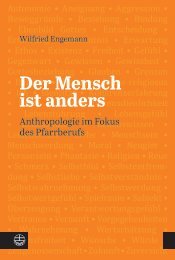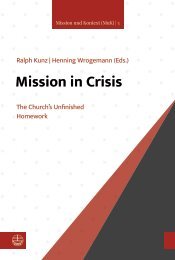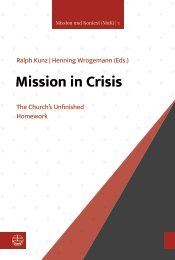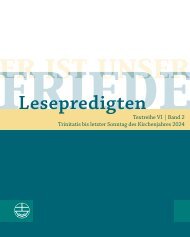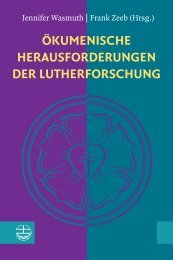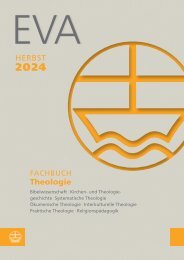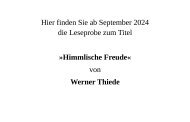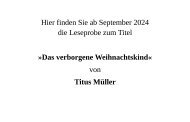Phillip A. Davis, Jr. | Daniel Lanzinger | Matthew Ryan Robinson (Eds.): What Does Theology Do, Actually? (Leseprobe)
Create successful ePaper yourself
Turn your PDF publications into a flip-book with our unique Google optimized e-Paper software.
42<br />
Anja Block<br />
method has its own focal point and interests, even though they sometimes intersect<br />
with each other. While some focus on synchronic observations, others have<br />
a diachronic interest. In introductory courses to Old Testament studies --- and, as<br />
an Old Testament scholar, I will focus my attention in the following on the Old<br />
Testament --- and corresponding textbooks such as Uwe Becker’s Exegese des<br />
Alten Testaments or Siegfried Kreuzer’s and Dieter Vieweger’s Proseminar Altes<br />
Testament, the methods are taught in a similar order.<br />
Once again, a preliminary translation, based on the Masoretic text, constitutes<br />
the first step. Second, textual criticism forms the basis for all of the following<br />
methods by considering variations of the transmitted text and their potential<br />
causes, such as scribal errors or deliberate adjustments of the wording. Scholars<br />
attempt to distinguish what changes might be earlier than others and closer to<br />
the version of a text that stood at the beginning of its transmission. 10<br />
Proceeding from the basis of the now established text, scholars ask about its<br />
formation using literary and redaction criticism. They search for incoherence<br />
and tensions within the text, look for doublets and inconsistencies and try to find<br />
traces of the textual growth. Understanding such complex redactional processes<br />
provides insights into the discourses that shaped the texts. Biblical texts formed<br />
under historical conditions, when, for example, a crisis like the Babylonian exile<br />
11 created new theological challenges for the communities for whom the texts<br />
held importance, prompting re-readings of those texts, the generation of new<br />
perspectives on previous certainties, and ultimately revision and growth of the<br />
texts. Certainly, the sages and scribes did not always agree, and their disagreein:<br />
Trutz Rendtorff, ed., Glaube und Toleranz: Das theologische Erbe der Aufklärung (Gütersloh:<br />
Gütersloher Verlagshaus Gerd Mohn, 1982), 30---42. All quotes are taken from the<br />
translation by John Barton: Barr, ‘‘Biblical Criticism as Theological Enlightenment’’].<br />
Even before him, Martin Hengel stated: ‘‘Die Redeweise von ‘der historisch-kritischen<br />
Methode’ ist fragwürdig. [...] In Wirklichkeit gibt es eine Vielfalt von ‘historischen Methoden’.’’<br />
Martin Hengel, ‘‘Historische Methoden und theologische Auslegung des Neuen<br />
Testaments,’’ Kerygma und <strong>Do</strong>gma 19 (1973): 85.<br />
In this essay, I use the phrase ‘historical-critical exegesis’ to summarize the aforementioned<br />
group of methods.<br />
10<br />
Particularly older publications describe, textual criticism as searching for the Urtext.<br />
This description, however, is overly simplified. As Alexander A. Fischer, among others,<br />
has pointed out, the time of a text’s composition and the time of its transmission blend<br />
into each other and therefore, the final form of a text is rarely identical to its Urtext. Cf.<br />
Alexander A. Fischer, Der Text des Alten Testaments: Neubearbeitung der Einführung in die<br />
Biblia Hebraica von Ernst Würthwein (Stuttgart: Deutsche Bibelgesellschaft, 2009), 188---<br />
94.<br />
11<br />
The Babylonian Exile is one prominent catalyst among others in Israelite history.<br />
Konrad Schmid has pointed out that similar developments in the history of Israelite theology<br />
after the destruction of the Northern Kingdom of Israel in 722 BCE led to important<br />
theological transformations after the destruction of Jerusalem’s temple in 587 BCE. Cf.<br />
Konrad Schmid, Theologie des Alten Testaments (Tübingen: Mohr Siebeck, 2019), 184.





